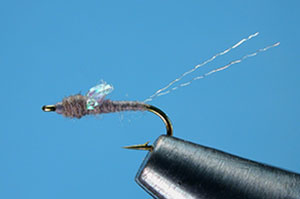Bobesh Hare's Ear
Dave HUghes
Translated by Carl Wuebben
The bobesh Czech nymph style started out as an imitation of a green rock worm caddis larva, and has been varied endlessly, the only difference being the color fur used for the body. Quite often it is mixed, with a “HOT SPOT” of fluorescent or UV dubbing in the center or at the head.
PATTERN
HOOK - heavy-wire curved scud sizes 6, 8, 10, 12
WEIGHT - 15 to 25 turns non-lead wire. Sized to hook shank
THREAD - brown 3/0 (210 denier) or 6/0 (140 denier)
SHELLBACK - clear thin skin (or ziploc bag)
RIB - copper wire
BODY - hare’s mask fur and sparkle yarn mixHOW TO TIE
- Debarb hook- mount in vise. Layer most of the hook shank with non-lead wire approximately the diameter of the hook shank. Start your thread in behind the hook eye and layer it all the way into the hook bend just a little bit while building up a small damn of thread in front of and behind the non-lead wire
- Clip a long strip of thin skin or other shellback material about one-half the hook gap wide. Clip the corners at one end to facilitate tying it in. Tie it in well down the bend of the hook, tie in two or three inches of ribbing wire at the hook bend area. Put them rearward to us later.
- Dub a long but thin amount of the fur and sparkle mix onto your thread by using the finger twisting method or a dubbing loop with a tool. Just make sure it’s tight.
- Wrap the dubbing forward to just behind the hook eye, leaving room for the thread head. The body should be tapered a little. (Thin in the rear) and tight. A tight body will help the fly sink. A loose and fibrous body might make the fly look more alive. But it also might prevent it from getting to the bottom as quickly.
- Draw the shellback forward over the body and tie off behind the eyelet. Clip off the tag end of the shellback. Wind the ribbing wire forward over the body and the shellback, segmenting the fly, and securing the shellback material in place. Tie off the ribbing and either clip or helicopter off the excess. Form a thread head which will not always be neat (the fish won’t inspect that part). Whip finish, clip thread tag end, put a very small dab of head cement on to help keep it together. As a final step, pick out a little of the fur from the underside of the nymph, but keep the amount minimal to avoid hindering the sinking.
- Try adding some red fur or synthetic dubbing to create a hot spot about ¼ inch back of the eye. Or you can even use a beadhead with the non-lead wire for extra heavyweight.
TIE UP A DOZEN OR TWO – AND GO FISHING*** But remember to practice C.P.R. (CATCH – PICTURE – RELEASE)
